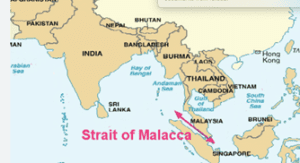THE CONTEXT: China is frequently intimidating Taiwan over the past year through deployment of its air force and navy in the surrounding areas.

CHINESE ACTIONS ON TAIWAN:
- Taiwan is an island, roughly 100 miles from the coast of south-east China.
- It has been governed independently of mainland China, officially the People’s Republic of China (PRC), since 1949.
- China rejected Taiwan’s participation as a member in UN agencies and other international organizations that limit membership to states.
- In 2021, China appeared to ramp up pressure by sending military aircraft into Taiwan’s Air Defence Zone, a self-declared area where foreign aircraft are identified, monitored, and controlled in the interests of national security.
- China launched a series of military exercises, including the firing of ballistic missiles, focused on six danger zones around Taiwan, three of which overlapped the island’s territorial waters.
- China also deployed naval ships and military aircraft in the region of strategic waters in the South China Sea and off the Taiwan’s northeastern coast which has also escalated the issue of national security.
SIGNIFICANCE OF STRAIT OF MALACCA:
- The Strait of Malacca connects the South China Sea with the Burma Sea.
- It is the shortest shipping channel between the Indian Ocean and the Pacific Ocean, linking major economies such as Middle East, China, Japan, South Korea, etc.
- The Strait of Malacca is on the transport route of approximately 25% of the oil transported between the Middle East and Asia.
- Approximately 60% of the world’s maritime transport passes through the Strait of Malacca.
- New Delhi’s main strategy regarding the Strait of Malacca relates to the strait becoming a gateway to its East View Policy.
- India attaches importance to the Strait of Malacca at the point of developing bilateral and regional relations through various cooperation mechanisms such as the Association of Southeast Asian Nations (ASEAN) Regional Forum.
LIMITED OPTIONS FOR INDIA:
- Distant blockades away from a belligerent nation’s geography can be challenged under international law.
- The trade that passes through the Strait of Malacca is not just China’s economic and energy lifeline. An overwhelming volume of the trade of Japan, South Korea and India passes through the same Strait.
- The channel of the Strait of Malacca is long, nearly 500 miles, and involves the sovereignty of other states such as Indonesia, Malaysia, Thailand and Singapore who would all be affected adversely by a naval blockade. The affected countries are unlikely to support a naval blockade.
- Commercial shipping is extremely complex to identify in terms of the sovereignty of the vessel, flag, registration, insurance and ownership of cargo. And these are often multinational in nature and can also be changed as convenient through transshipment at any port in Southeast Asia.
- The additional reality is that even if the Strait of Malacca were blocked, large carriers transporting goods to China can use alternative routes, such as the Sunda or Lombok Straits.
- China also has a huge onshore and floating Strategic Petroleum Reserves (SPR) which can help it tide over disruptions, especially with growing overland energy supplies from Russia and Central Asia.
WHAT HAPPENED IN THE PAST:
- During the First World War, the British blockade of Germany which lasted from 1914-19 saw Germany retaliating against British shipping on the high seas with its submarines (U-boats) with deadly effect.
- Subsequent developments, including the Battle of Jutland in 1916 and the sinking of U.S. merchant vessels by German U-boats eventually drew the U.S. into the First World War.
- During the Second World War, the U.S. had embargoed Japan’s energy supplies which ran through the maritime commons, which probably played a key role in Japan’s decision to launch the attack on Pearl Harbour in December 1941.
THE WAY FORWARD:
- India should pay constant and careful attention to this issue.
- Any speculative action in the Strait of Malacca or the Andaman Sea would involve either a naval blockade against commercial shipping or China’s key trade and energy sea lines of communication or military action against Chinese naval vessels.
- The fact is that commercial shipping as well as naval vessels of any country have a right to freedom of navigation on the high seas.
- A naval blockade against commercial shipping is not feasible.
- The new U.S.-India partnership in the economic, high-tech and military areas is expected to strengthen in the years ahead. The U.S. increasingly regards India as regional ballast for stability in the region.
- A robust India with a strong economy, nuclear deterrence capability and a credible military can contribute to multi-polarity in the Indo-Pacific.
THE CONCLUSION:
India’s primary role may be limited to a proactive defence of its territorial interests and the security of its sea lines of communication and those of its strategic partners in the eastern and western India Ocean.
PREVIOUS YEAR QUESTIONS:
Q) Virus of Conflict is affecting the functioning of the SCO; In the light of the above statement point out the role of India in mitigating the problems. (2023)
Q) Critically examine the aims and objectives of SCO. What importance does it hold for India? (2021)
MAINS PRACTICE QUESTION:
Q) Explain the strategic importance of the Indo-Pacific region to India and also highlight the significance of Strait of Malacca in international trade.
SOURCE: Taiwan, a Malacca blockade and India’s options – The Hindu
Spread the Word
